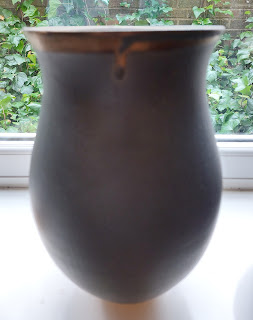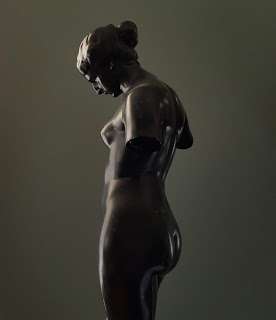I can't remember the exact year, but I know I was quite young and I was not allowed to stay up late. But on this occasion I had somehow slipped through the dragnet of home discipline and found myself watching TV late at night. Alone.
Though this seemed like a treat, this was the 70's and way before all night television had been sanctioned by the milk snatcher, Thatcher.
There was the testcard. That strange surreal image of a young girl with some form of a puppet in her hand. If you fell asleep there was a piercing sound that was suppose to wake you up.
Or there was, late nights on BBC2, and as I swept the...dial around, to change channels, I found the Open University. Wow, exciting I thought.
It was not quite the contra band that I was looking for. The last time I had escaped the sleep shackles I had watched 'The Invisible Shrinking Man' in black and white.
It had scared the life out of me.
The giant spider hunting the slowly diminishing character left a particular impression.
I may as well go to bed I though as the novelty of being up late had worn off.
Then a programme started.
In black and white, but immediately I was captured by an image that may well have changed my life.
It was a bronze head with striated lines incised into it, lines that rolled down the contours of the cheeks.
It was a dark colour and had overall shape that was different. Made of metal.
It was a Benin bronze bust.
I was transfixed as the black and white screen seemed as if by magic to turn to technicolour as my imagination tripped in on what I was seeing.
Or what seemed to be seeing me. Staring back at me from the tiny monochrome screen.
The glare from the wonder with those scarifications woke me up. I was going nowhere.
The filmaker had the camera pan around this wonderous object, while the narrator told the story in that typical colonial BBC plum in mouth language. Stating that “When they were 'found' it. It was thought that a ancient greek civilisation had been discovered”.
Well what they were trying to say is that the people of Africa were not clever enough to make objects that scrap up to western art.
But I saw something more. I felt a power that was not like the ornementation around me. Those strange Capi demonte style porcelain things in peoples houses that I saw on sideboards.
I did not know why, at this early morning time. Nor did I understand how these images described, as if they were “lost castings by Donatello” the great Florentine Renaissance scupltor. But they hooked me in.
The admiratation through gritted teeth, was taken away by the overarching slur that at the time they were found, that no African was capable of producing, or understanding the lost wax process.
How the BBC loved to demean. David Attenborough just about got away with it.
In the bush, finding pygmies, to make himself look and sound clever with his BBC speak.
But I saw something else from the spot on the floor, in front of that box of images. That night, that changed my life. I did not understand then, just what it was that pulled me out of my armchair. Whether it was the story of the intrepid explorers who had “found” them.
Or how they made a measured encroachment into my soul as if they were talking to me.
I was looking at the image of a past being who wanted to engage my stare.

This ancient ruler of Ife would have no idea that I would be peering through the medium of the 20th century.
Through that box in the living room, that transported you to places in the past.
To distant lands.
This would be decades before I discovered the genius of Louis Armstrong and The Duke of Ellington.
But those images stayed with me as I sometimes caught sight of them again.
Over the years they became familiar to me.
I would eventually see some of them in the British museum. Where I would not be impressed with all. But several of the busts would help me understand that art is emotion and most of the icons of the 20th century were directly or maybe indirectly inspired by 'primitive work' such as these bronzes. More than I had first thought.
Greek art, above Roman would be created, to attempt to capture the spirit of a being, rather than just the likeness.
Felix von Luschan, a curator at the Berlin Ethnographic Museum, explained to an audience more familiar with European art, famously comparing them to the work of celebrated Italian Renaissance sculptor, stating, ‘Benvenuto Cellini could not have made a better cast himself, and no one has before or since, even to the present day. These bronzes stand even at the summit of what can be technically achieved.’ he added.
We say bronzes but more accuratly they were cast from brass, copper and sometimes bronze.
In the Edo language, the verb sa-e-y-ama means ‘to remember’, but its literal translation is ‘to cast a motif in bronze’.
At the courts of Benin, art in bronze perpetuates memory; and the first commissions of every Benin king were, and are sculptures, in bronze and ivory, for his father’s altar. To remember him.
Benin bronzes went into some of the most prestigous European collections.
After the British occupation of Benin City in 1897, during the reign of Oba Ovonramwen (1888–97). By August 1898, most of the ivory and bronze artworks seized by the British from the royal treasury had been sold in large public auctions.
This was the age when colonials thought they could go round looting the heritage of ancient civilisations.
By the early 1900's, nearly all of the bronzes were in public and private collections in the United Kingdom, Germany and Austria. The Obas of Benin have been asking for their return for decades.
National Museum of Nigeria and Lagos houses the collection of Ife art.
Ile Ife as it is known was a city in Nigeria and was ruled by The Oba.
Yoruba, the ethnic group in the region describe Ife as their spiritual capital. The current inhabitants have decided that it is where the civilisation came from.And all will return for re-incarnation.
Ife sculptures have a unparalled realism.
Crowns of glass beads encrusted the sculptures.
Usually you would not see the face of the Oni and there are holes that hold beads which cover the face. They may have been worn.
Yoruba polyrythyms would mix with Portuguese as early as the 16th century and become european music.
Fandango's and the like, played in some of the most prestigious courts. Syncopated by african drums.
Several more sculptures were found in 1938 when builders were remodelling a house.
Leo Frobenius a German archeologist took pictures of them and the villages from where they came.
Picasso and others would help it along.
I know how it shaped my understanding of art and I will never forget my introduction into the captured majesty of those ancient Oba sculptures that now mean more to me than the slush of Victoriana I see in most collections.
I sincerely hope, that I now can begin to understand the imagery of Polynesian art and some of the beautiful First Nation American work.
The often overlooked art that my good friend and fellow specialist Ronnie Archer Morgan has brought into the living rooms of those watching the Antiques Roadshow on a Sunday evening.
I
so admire how he has slowly introduced art lovers to the history of
modern art through cultures past. I love how he explains the
figurative meanings within, simple art that has a complicated past.
I hope I may now understand a little more about those geometric patterns associated with modernity that were often looted from kingdoms past, in Africa. And in ancient Egypt.
When Tutenkhamun was discovered the world went crazy for those geometric hieroglyphs and these images that were sewn into society along with ancient rythmic syncopations from deep dark and distant worlds that originated not far from the River Niger. From the Yoruba. Jazz was created in Congo square, and is the biggest cultural contribution that America has contributed to the world.
But it came from Africa. Where the Oba ruled. Ife. In the delta that shaped the world.
That took Vodun across a ocean.
From Dahomey.

I studied for my pottery sculpture.
I decided decades later, without thinking and subconsiously that I would burnish hand thrown pots with the tone of 'skin'. And I would decorate them with markings from where I did not know. http://www.classicartdeco.co.uk/my-own-work.php
I do now.
Modern art, for me, started when the Oba stared back at me one dark night when my eyes met his ancient face.
When I was young.
I have never forgotten that face.




















